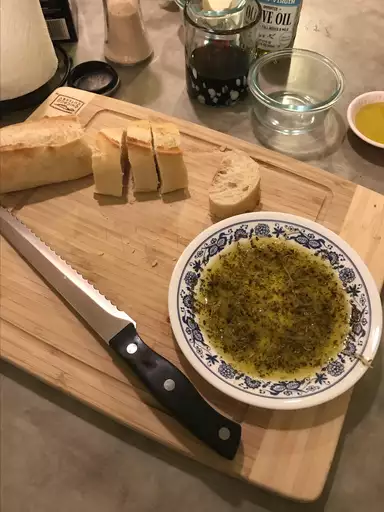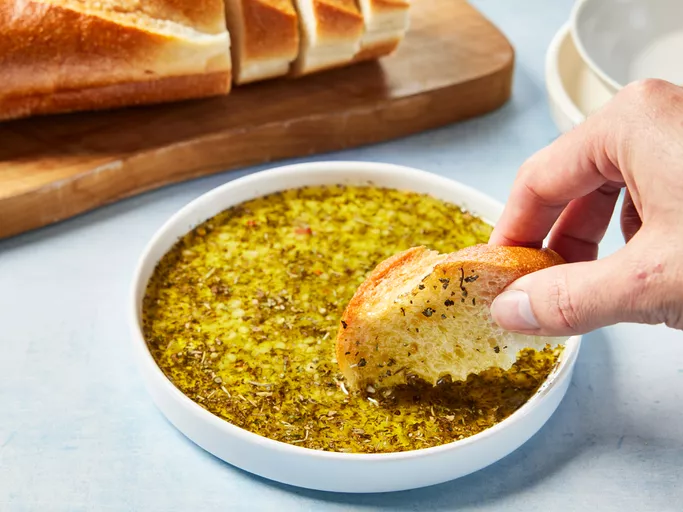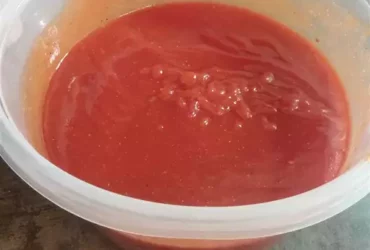Ingredients
Essential Oils
In order to create a delicious bread dipping oil recipe, you will need some essential ingredients.
The first ingredient is olive oil. This is the base of the dipping oil and provides the richness and depth of flavor. Choose a high-quality extra virgin olive oil for the best results.
Next, add in some garlic. You can use either fresh or dried garlic, depending on your personal preference. If using fresh, mince 2-3 cloves and sauté them in a pan until softened before adding to the olive oil. For dried garlic, simply crush 1/2 teaspoon into a fine powder and mix with the olive oil.
Herbs are also an essential component of bread dipping oil. Choose your favorite herbs such as rosemary, thyme, or oregano. Fresh or dried herbs can be used, but fresh is recommended for the best flavor.
For a Mediterranean-inspired flavor, add some lemon juice and zest to the mixture. Use 1-2 tablespoons of freshly squeezed lemon juice and grate 1/4 teaspoon of lemon zest into the olive oil.
Spices can also be added to customize the flavor to your liking. Common spices used in bread dipping oil include paprika, cayenne pepper, or black pepper.
To make the bread dipping oil, combine all the ingredients in a small bowl and stir until well combined. Taste and adjust the seasoning as needed.
Here is a list of ingredients for a basic bread dipping oil recipe:
- Olive Oil: 1/2 cup extra virgin olive oil
- Garlic: 2-3 cloves fresh garlic or 1/2 teaspoon dried garlic
- Herbs: 1 tablespoon chopped fresh herbs (such as rosemary, thyme, or oregano)
- Lemon Juice and Zest: 1-2 tablespoons freshly squeezed lemon juice and 1/4 teaspoon grated lemon zest
- Spices: Add to taste (such as paprika, cayenne pepper, or black pepper)
This bread dipping oil recipe is perfect for serving with crusty bread, crackers, or vegetables. You can adjust the ingredients to suit your personal taste preferences and create different flavor combinations.
1/4 cup extra virgin olive oil
Olive oil is a staple ingredient in many Mediterranean cuisines, and for good reason. It’s rich in flavor and has numerous health benefits when consumed in moderation.
The bread dipping oil recipe calls for 1/4 cup of extra virgin olive oil. This type of oil is made from the first pressing of olives and contains a higher concentration of antioxidants and healthier fats compared to regular olive oil.
Here are some key characteristics of high-quality extra virgin olive oil:
- Color: Deep green or golden in color, depending on the type of olives used
- Smell: Fruity and herbaceous aroma
- Taste: Bitterness and peppery flavors, with hints of fruitiness and grassy notes
- Purity: Free from impurities and additives
When selecting a high-quality extra virgin olive oil for your bread dipping oil recipe, look for the following:
- Certifications such as “extra virgin” or “first cold press”
- A clear label indicating the type of olives used (e.g. Arbequina, Frantoio)
- A reputable brand with a strong track record for producing high-quality oils
Incorporating 1/4 cup of extra virgin olive oil into your bread dipping oil recipe will add depth and richness to the flavors. You can also experiment with different types of olives or blends to create unique flavor profiles.
Aromatic Herbs
A variety of aromatic herbs can be used to create a flavorful bread dipping oil, and each type of herb brings its unique characteristics to the dish. Here are some popular options:
- Italian Seasoning: A blend of herbs including basil, oregano, thyme, and rosemary, this classic combination is often used in Italian cooking.
- Basil: Known for its sweet, slightly spicy flavor and aroma, fresh or dried basil can be added to the oil for a classic Italian taste.
- Oregano: Pungent and earthy, oregano is often used in combination with other herbs like thyme and rosemary to create a savory bread dipping oil.
- Thyme: A versatile herb that adds depth and warmth to the oil, fresh or dried thyme can be used alone or in combination with other herbs.
- Rosemary: With its piney, herbaceous flavor, rosemary is a popular choice for bread dipping oil, especially when combined with garlic and lemon juice.
Other aromatic herbs that can be used to create a unique bread dipping oil include:
- Garlic: Minced or roasted garlic adds a savory flavor to the oil and pairs well with many types of herbs.
- Lemon Zest: Adding grated lemon zest to the oil gives it a bright, citrusy flavor that complements many herbal combinations.
- Cilantro: With its fresh, green flavor, cilantro is often used in Mexican and Asian cooking and can add a unique twist to bread dipping oil.
2 cloves garlic, minced
Garlic is one of the essential ingredients in this Bread Dipping Oil Recipe. The recipe calls for 2 cloves of garlic, which are minced to release their flavors and oils.
To mince the garlic, you will need a sharp knife and a cutting board. First, peel the garlic cloves by placing them under running water or gently rubbing off the papery skin with your fingers.
Next, place one of the peeled garlic cloves on the cutting board and hold it firmly in place with your non-dominant hand. Using a sharp knife, chop the garlic clove into small pieces, making sure not to crush it.
Continue chopping until you have 2 minced garlic cloves as required by the recipe. You can mince the garlic using a chef’s knife or a garlic press, depending on your personal preference and the texture of the garlic that you prefer in your dish.
The key to getting the right amount of flavor from your garlic is to not over-chop it. Mincing the garlic releases its oils and enzymes, which are responsible for giving it its unique taste and aroma. Over-chopping can result in a bitter or unpleasant flavor, so make sure to stop chopping once you have reached the desired consistency.
Now that your garlic is minced, you can proceed with making the Bread Dipping Oil Recipe by combining the garlic with olive oil, herbs, spices, and other ingredients. The minced garlic will infuse into the oil and give it a rich, savory flavor that complements perfectly with crusty bread.
1 tablespoon chopped fresh rosemary leaves
Rosemary is a fragrant, herbaceous ingredient commonly used in Mediterranean and Italian cuisine. In the context of this Bread Dipping Oil Recipe, rosemary adds a piney, slightly bitter flavor that complements the richness of the olive oil and other ingredients.
The specific type of rosemary called for in this recipe is fresh rosemary leaves. This means you’ll want to use fresh rosemary sprigs from your garden or purchase them from a reputable grocery store. Fresh rosemary has a more delicate flavor than dried rosemary, which can be quite potent.
To prepare the rosemary for this recipe, you’ll need to chop it into small pieces. This involves cutting off the leaves from the stem and then finely chopping them with a knife or kitchen shears. You’re looking for about 1 tablespoon of chopped fresh rosemary leaves, which will give your bread dipping oil a subtle yet aromatic flavor.
In terms of storage, it’s best to keep your freshly chopped rosemary in an airtight container in the refrigerator to preserve its flavor and aroma. You can also freeze it if you won’t be using it immediately, but be sure to label and date the container so you know what you’re working with.
Remember, when using fresh rosemary, less is often more. The flavor of this herb can quickly overpower other ingredients, so start with a small amount and adjust to taste. In the case of this bread dipping oil recipe, 1 tablespoon of chopped fresh rosemary leaves should provide a nice balance of flavors without overwhelming the senses.
1 tablespoon chopped fresh thyme leaves
When it comes to ingredients, one of the key components that makes our bread dipping oil recipe truly special is the fresh thyme leaves. Fresh thyme adds a bright, herbaceous flavor that complements the richness of the olive oil and garlic perfectly.
To incorporate fresh thyme into your bread dipping oil, you’ll need to start by chopping it finely. This will release its essential oils and allow them to infuse evenly throughout the dish.
The amount of fresh thyme used in this recipe is quite modest – just 1 tablespoon chopped leaves. However, don’t be fooled by its small quantity; even a small amount can make a big impact on the overall flavor profile of your bread dipping oil.
For best results, use the freshest thyme sprigs you can find and chop them immediately before adding them to your recipe. This will ensure that they retain their potency and add the most depth and complexity to your dish.
Remember, when working with fresh herbs like thyme, it’s all about balance. A little goes a long way, so start with this small amount and adjust to taste. You can always add more fresh thyme if needed, but it’s much harder to remove the flavor once it’s been added.
As you combine your chopped thyme with the other ingredients in your bread dipping oil recipe – including olive oil, garlic, salt, and maybe some lemon zest or red pepper flakes – be sure to stir everything together thoroughly. This will help distribute the fresh thyme evenly throughout the mixture and ensure that every bite is infused with its delightful flavor.
The result of using 1 tablespoon chopped fresh thyme leaves in your bread dipping oil recipe will be a beautifully balanced, aromatic condiment that’s perfect for dipping crusty bread, veggies, or even crackers. It’s sure to become a staple in your kitchen and elevate any meal into something truly special!
Instructions
Mixing the Oil Blend
To begin mixing the oil blend for your homemade bread dipping oil recipe, you’ll first need to gather all the necessary ingredients and equipment.
The basic components of a traditional bread dipping oil include olive oil, garlic, herbs, and sometimes citrus or spices.
For this particular recipe, we recommend using high-quality extra-virgin olive oil as the base for its rich flavor and health benefits.
You’ll also need to have some fresh garlic cloves on hand; we recommend peeling and mincing three to four cloves per batch depending on your personal taste preferences.
Additionally, choose a mix of herbs that complement the flavors you enjoy most. Popular options include rosemary, thyme, oregano, basil, and parsley.
You can either use dried herbs or fresh ones, depending on what’s available in your area; just make sure to adjust the quantity according to their potency.
Other optional ingredients that add depth and aroma to your bread dipping oil include grated lemon zest, minced onion, or a pinch of red pepper flakes for an extra kick.
When it comes to mixing the blend, start by pouring the olive oil into a bowl that’s large enough to hold all the ingredients without spilling over. We recommend using at least 1/2 cup of olive oil for each batch.
Add in your minced garlic and mix well with a spoon or whisk until the garlic is evenly distributed throughout the oil. Be careful not to create any foam, as this can cause the oil to separate later on.
Next, add in your chosen herbs and spices along with any optional ingredients you’re using. Mix gently to avoid bruising the delicate herb leaves or releasing their flavors too quickly.
As a general rule of thumb, start by adding about 1 tablespoon of dried herbs per cup of oil, or 2-3 sprigs of fresh herbs. You can always adjust the quantity to taste later on.
Continue mixing until all the ingredients are fully incorporated and you’re left with a smooth, consistent blend. Be sure to scrape down the sides of the bowl as needed to avoid any hidden pockets of unmixed oil or spices.
Once your bread dipping oil is mixed, transfer it to an airtight container such as a glass jar with a tight-fitting lid. This will help preserve the flavors and prevent the oil from becoming rancid over time.
Now that you have your homemade bread dipping oil recipe mixed and ready to go, be sure to store it in a cool, dark place away from direct sunlight or heat sources. With proper care and handling, this delicious blend can last for several weeks to months and add flavor to countless meals and snacks along the way.
Combine olive oil, garlic, and herbs in a bowl.
The art of creating the perfect bread dipping oil recipe involves attention to detail and a thorough understanding of the key ingredients involved. In this case, we’ll be focusing on combining olive oil, garlic, and herbs in a bowl. This process requires a deliberate approach to ensure that the final product meets your expectations.
Begin by selecting a high-quality extra virgin olive oil as the base for your bread dipping oil. Choose an oil with a mild or peppery flavor depending on your personal preference. A good rule of thumb is to select an oil with a pH level close to 7, which will provide a balanced and smooth taste.
Next, mince the garlic cloves and add them to the bowl. Be cautious not to overpower the dish with too much garlic, as it can quickly dominate the flavor profile. A good ratio is to use about one clove of garlic per tablespoon of olive oil.
Now, let’s talk about herbs – a crucial component in creating an aromatic and fragrant bread dipping oil. Choose fresh or dried herbs that complement your olive oil selection. Classic options include basil, oregano, thyme, or rosemary. Feel free to experiment with different combinations to find the perfect blend for your taste buds.
When selecting herbs, make sure they are at their peak freshness to ensure optimal flavor and aroma. If using fresh herbs, chop them finely before adding them to the bowl. For dried herbs, use about one-third of the amount as you would with fresh herbs.
Add a pinch of salt to enhance the flavors and bring out the natural sweetness in your olive oil. Be mindful not to overdo it on the salt, as it can quickly become overpowering. A light hand will allow the other ingredients to shine through.
Combine all the ingredients in a bowl and whisk gently until they’re evenly distributed. You can use a spoon or a small whisk for this step. Make sure to scrape down the sides of the bowl to ensure everything is well incorporated.
The final step is to let your bread dipping oil sit at room temperature, allowing the flavors to meld together. This process typically takes about 30 minutes to an hour. During this time, you can store it in a cool place or refrigerate it for later use.
Whisk until smooth and well combined.
To ensure that the ingredients for our delicious Bread Dipping Oil recipe are properly incorporated, follow these steps:
Step 1: Whisk until smooth and well combined.
This step is crucial in bringing together the various components of the oil mixture. To achieve a silky texture, whisk the ingredients continuously until they have reached a smooth and even consistency.
Here’s how to do it:
- Hold the whisk firmly but gently over the bowl containing the oil mixture.
- Pull the whisk down into the oil, applying moderate pressure to ensure all ingredients are well-coated and evenly distributed.
- Continue whisking in a smooth, flowing motion, pausing only occasionally to check on the consistency of the mixture.
The Signs that Indicate Smoothness
You can tell when the oil mixture has reached the desired level of smoothness by looking for these signs:
- Even coloration – The mixture should be uniformly colored, with no streaks or patches.
- Uniform consistency – The texture should be silky and even throughout, without any lumps or thick spots.
Tips for Smooth Whisking
To make whisking easier and more efficient, keep the following tips in mind:
- Use a high-quality whisk with sturdy wires that can withstand continuous use.
- Work over a stable surface to prevent accidents or spills.
By following these steps and paying attention to the signs of smoothness, you’ll be able to create a beautifully blended oil mixture that’s perfect for dipping your favorite breads.
Usage Tips
Bread Selection
The type of bread you select for dipping into oil can greatly enhance the overall experience. Here are some tips to help you make the most of your bread selection:
- Choose a rustic or artisanal bread with some texture and depth, such as baguette slices, ciabatta, or grissini.
- A firmer bread, like rustic Italian or sourdough, will hold up better to the dipping process than softer varieties.
- Consider the flavor profile of your bread and how it might complement the herbs and spices in your dipping oil. For example, a lightly sweetened bread pairs well with olive oil infused with garlic and herbs.
- You can also experiment with different shapes and sizes of bread to create an attractive presentation, such as cutting baguette slices into quarters or using mini breadsticks.
Some popular types of bread for dipping include:
- Baguette: A classic French bread perfect for sopping up flavorful oils and herbs.
- Ciabatta: An Italian bread with a slightly crispy crust and airy interior that pairs well with robust dipping oils.
- Grissini: Thin, crisp Italian sticks ideal for dipping into light, herby oils.
In addition to these bread types, you can also try using:
- Rustic Italian bread: A hearty bread with a slightly crispy crust and chewy interior that’s perfect for sopping up rich dipping oils.
- Sourdough: A tangy, slightly sour bread that pairs well with bold flavors in the dipping oil.
Ultimately, the type of bread you choose will depend on your personal preferences and the flavor profile of your dipping oil. Experiment with different types and shapes to find the perfect combination for your taste buds.
Use rustic breads like baguette or ciabatta for best results.
To achieve optimal flavor and texture when using our Bread Dipping Oil Recipe, it’s essential to choose the right type of bread.
We highly recommend using rustic breads like baguette or ciabatta for best results.
Why Rustic Breads?
Rustic breads are ideal because they have a coarser texture and a chewier crumb than other types of bread.
This texture allows the dipping oil to cling to the bread more effectively, creating a richer and more intense flavor experience.
What Types of Rustic Breads to Use?
- Baguette: This classic French bread is perfect for dipping in olive oil. Its crusty exterior gives way to a soft interior that’s just begging to be dipped.
- Ciabatta: This Italian bread has a light, airy texture and a slightly crispy crust. It pairs beautifully with our Bread Dipping Oil Recipe.
Tips for Using Rustic Breads with Our Recipe
- Cut the bread into bite-sized pieces: This will make it easier to dip and coat each piece evenly.
- Toast the bread lightly: This will help bring out the natural flavors of the bread and complement the dipping oil.
In summary, using rustic breads like baguette or ciabatta is key to getting the most out of our Bread Dipping Oil Recipe. By following these simple tips, you’ll be able to create a delicious and flavorful experience that’s sure to impress your friends and family.
Serving Suggestions
To get the most out of your homemade bread dipping oil, consider the following usage tips:
- Store it properly: Keep the bread dipping oil recipe in an airtight container to prevent it from coming into contact with air and developing off-flavors or mold.
- Use high-quality ingredients: The quality of your ingredients will directly impact the flavor and aroma of your finished bread dipping oil, so choose fresh garlic, fragrant herbs like rosemary or thyme, and a good-quality olive oil.
- Balance flavors: Taste and adjust the seasoning as you go to ensure that the flavors in your bread dipping oil are balanced and harmonious.
- Experiment with different flavor combinations: While traditional Italian seasonings like garlic and herbs are always a winner, feel free to get creative with other ingredients like lemon zest, red pepper flakes, or sun-dried tomatoes.
- To serve, consider the following suggestions:
- Serve as a dip for bread: This is the most obvious way to enjoy your homemade bread dipping oil, but don’t be afraid to try it as a sauce for grilled meats or vegetables, or even as a finishing oil for soups and salads.
- Offer with appetizers: Bread dipping oil makes a great accompaniment to appetizers like bruschetta, olives, or cheese and crackers.
- Pair with pasta dishes: A light drizzle of bread dipping oil can add brightness and depth to a simple pasta dish, especially when paired with rich ingredients like sausage or mushrooms.
- Use as a condiment: Keep a small bowl of bread dipping oil on hand as a condiment for pizza nights, parties, or family gatherings – it’s a crowd-pleaser every time!
Serve with warm bread, ideal for dipping.
- Serving your homemade Bread Dipping Oil with warm bread is an excellent way to enhance the overall dining experience.
- The ideal type of bread to use for dipping is one that is fresh and soft, such as Ciabatta, Focaccia, or Sourdough
- To make the most out of your Bread Dipping Oil, it’s best to serve it with bread that has a slightly crispy crust on the outside and a soft interior.
- This allows for a perfect balance between texture and flavor, making each bite a delightful experience.
- The warmth of the bread helps to bring out the aromatic flavors in the oil mixture, while also providing a comfortable temperature for dipping.
- When serving with warm bread, be sure to have a variety of dippers on hand to cater to different tastes and preferences.
- This can include an assortment of crackers, crusty baguette slices, or even crostini topped with herbs and spices.
- Offering multiple options allows your guests to explore the flavors of the Bread Dipping Oil in different ways, making for a more engaging experience at the dinner table.
- In addition to serving warm bread, consider pairing it with other complementary items such as roasted vegetables, meats, or cheeses for added flavor and texture combinations.
- Best Datanyze Alternatives for 2025 - April 24, 2025
- Best Hunter.io Alternatives for 2025 - April 22, 2025
- Best Lead411 Alternatives for 2025 - April 22, 2025















